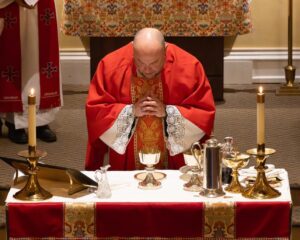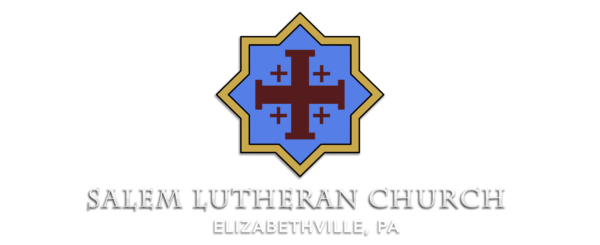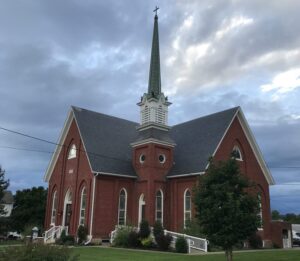Why we do the things that we do in church…
The Liturgy can be divided into four different sections called the Ordo: Gathering, Word, Meal, Sending.
When we gather, we do so by beginning with Corporate Confession and Forgiveness. The Confession and Forgiveness part of the liturgy is really not a part of the Sunday morning liturgy. It is done outside the liturgy as a preparation for what is about to unfold. Our liturgy begins with a hymn, followed by the Apostolic Greeting, Kyrie, Canticle of Praise, and Prayer of the Day.
Confession and Forgivessness
We come knowing that we have sinned and fallen short of God’s glory daily. We sin through thought, word, and deed. The Law condemns us but our gospel reminds us that we know forgiveness and life. The first words of our litury remind of the grace God has to offer for us. Even though this forgiveness is temporary, it is an important reminder of God’s grace and love.
Apostolic Greeting
“The grace of our Lord Jesus Christ, the love of God, and the communion of the Holy Spirit be with you all.” These words were used by St. Paul to open and conclude most of his letters. The congregation responds with, “And with your spirit.” These words are not simply returning the favor back to the pastor, but bring us into union with our heavenly God. We have the grace of God bestowed to us by God and we offer that Grace back to God and the pastor.
Kyrie
From the Greek word which means Lord. The Kyrie is short of Kyrie Eleison. During this time, we chant back and forth that our Lord would have mercy on us. We pray particularly for peace, For peace from above; for our salvation; for the church; for all who offer worship praise, and for Christ help, comfort and defense. The Kyrie is one way that we pray to God and the prayer is the same prayer we offer week after week. These needs do not change.
Prayer of the Day
The Prayer of the Day is typically a prayer focused around the texts appointed for the day and usually is led by the presiding minister.
The next part of our ordo is the Word or Liturgy of the Word.
There are typically four lessons read from the gospel. The first is usually from the Old Testament which tends to follow a similar theme of the gospel, the second is a Psalm, the third is taken from an Epistle or Letter and then the final reading comes from the gospel. We believe that the word is one way that God speaks to us. God also speaks to us in through the preaching and singing. From the document called the Means of Grace: viva vox evangelii is “the living voice of the gospel”
- It is the voice of God calling Elijah in the silence that follows the storm.
- It is the voice of the angels calling the unsuspecting shepherds to see God with them.
- It is the voice you embody–from the organ bench, from the pulpit, from the bedside -as you participate in God’s new life.
After the reading of the second lesson, the congregation stands to greet the gospel. We believe that God is present when we read God’s word a loud and so we welcome God’s presence through singing, “Alleluia, Lord to whom shall we go? You have the words of eternal life. Alleluia!” After this, the gospel is announced and read. The pastor traces a cross over the words of the Gospel. A cross may also be traced on one’s forehead, mouth, and heart as a reminder that Christ is about to speak to us and we will hear him through through our minds, our voices and our heart.
After the sermon and the hymn of the day (this hymn further drives home the point of the sermon because even if the pastor fails at proclaiming the word of God, the gospel can still be proclaimed through the hymn) we then join in confessing our Christian faith through one of the appointed creeds of the church (Apostles’ Creed, Nicene Creed, or Athanasian Creed). The Nicene Creed was composed by the Ecumenical Council of 325. The group met in Nicea to talk about the disagreements between the Eastern and Western churches. From that Council, the first two paragraphs of the creed were created. The third paragraph was added in 381 and essentially led to the Great Schism of Orthodoxy. Today, the Nicene Creed is used for special occasions in the Lutheran Church such as feast days and celebrations.
The Apostles’ creed is different from the Nicene Creed in the fact that we do not who is the author. Some traditions say that each of the original disciples each wrote a line of creed, but no such proof of that can be found. What is most likely the case is that the Apostles’ Creed is based on the belief and teachings of the apostles. This creed has been traced back to ancient baptismal services. Lutherans often use this as our weekly creed to drive home the importance of baptism.
The Athanasian Creed is rarely used in Church but is one of the Creeds that we confess to believe and teach as a church. The Creed is attributed to a man named Athanasius and is a statement of belief focused on Trinitarian doctrine and Christology. While Athanasius was a champion of the Christian Faith, he mostly did not write it because the creed was originally written in Latin and Athanasius spoke only in Greek. None-the-less, this creed still teaches us and helps us understand the mysteries of the Trinity. We continue to use these creeds in worship because they allow us to faithfully summarize our beliefs as one people.
After this, prayers of intercession are offered and then the congregation shares the peace of God with one another. We ask that everyone share a sign of God’s peace with your neighbor in a way that you feel most comfortable. After you have exchanged the peace with those around you, please return to your pews and be seated.
After the Word, we come the third part of the ordo called the The Meal or Liturgy of the Eucharist.

Offertory Canticle and the Offering
A canticle (or hymn) is played as the gifts are brought forward to the Altar and offered up to God. The canticle reminds us of God’s Abundance and all that we have comes from God. We offer back just a small portion of God’s abundance so that the mission of God can be done. But it is not just money that we offer, but also the bread and wine. It is in this meal that Jesus Christ is truly present and when we feast on his body and blood, we recieve the spiritual nutrients necessary to carry out the mission of the gospel.
The Great Thanksgiving
Think about the Thanksgiving meal we share with our family in November. We share a meal with our loved ones and celebrate all that we are thankful for over the past year. The church’s thanksgiving focuses us on being thankful for all that God has given to us.
P: “Lift up your hearts.”
C: “We lift them up to the Lord.”
P: “Let us give thanks to the Lord, our God.”
C: “It is right to give him thanks and praise.”
P: “It is meet, right, and salutary that we should at all times and in all places offer thanks and praise…”
After this dialog, we sing a canticle called the Sanctus. It is here that we glimpse just a glimmer of God’s inbreaking in our word. It is certainly the climax of our liturgy. The first part of the canticle is taken from Isaiah 6. The prophet sees a vision of Angels bowing before God and singing “Holy, Holy, Holy.” It is tradition that a person bow during the singing because the angels also bowed because they could not bear the holiness of God. The Second part is taken from the gospel accounts of Jesus’ entry into Jerusalem when the people shouted, “Hosanna! Blessed is he who comes in the name of the Lord.” To remind ourselves that we are blessed because of the one who comes in the name of the Lord many make a sign of the cross at these words.
Eucharistic Prayer
The Pastor then offers a prayer to God asking that God send the Holy Spirit to this meal and we ask that Christ fulfill his promise to be in the bread and the wine. The Eucharistic prayer is both consecratory and proclamation. We believe that when we ask God to send the Holy Spirit upon the bread and wine that God will do so. When we recite scripture (such as the words of institution) or recall a pivotal event in scripture, we are proclaiming the word of God.
The Lord’s Prayer
After the Eucharistic Prayer, we pray the words that our Lord once taught his followers to prayer. Our Lord taught us this prayer to say together in community as well as when we had no words left to say. We do as our Lord taught us to pray.
Agnus Dei
The Agnus Dei is Latin for “Lamb of God” and is a title for Jesus that appears in the Gospel of John (1:29). It is here that we are reminded that our Lord is present and we are to behold his glory.
Communion Distribution
All Baptized Christians are welcome to receive this day. If you do not feel the need to commune this day for spiritual, emotional or any other reason, you may either remain seated or come forward and receive a blessing. If you, for mobility reasons, cannot come forward, please let the usher know and the Pastor will come back to your pew. When you come forward, you will first recieve the host and the leader will say, “The body of Christ given for you.” As Lutherans, we know this to be true and the disciple is invited to say Amen. Amen means, “Yes. It shall be so.” We say amen instead of “thank you” or “thanks be to God” as a mark of our faith in the holy sacrament being what it said to be. The same is true when recieving the wine and hearing, “The blood of Christ, shed for you.” We know this to be true so instead of offering thanks to God, we accept it willingly as not something we deserve, but because God is mericiful and gives us this meal despite ourselves.
Following the distribution, we have the final part of the Ordo called the Sending.
Benediction
God’s mission includes the gifts of grace that we share in worship and take also to the absent; now, we are sent to continue our participation in God’s mission. With the blessing of God, we go out to live as Christ’s body in the world.
Closing Hymn
Lutherans love to sing and cannot find a better way to conclude our worship than through song.
Dismissal
The dismissal first appeared in the Lutheran Book of Worship in 1978. This line in Latin is called “The Mass.” The whole point of gathering for worship is to be sent out. It reminds us that our worship does not just end on Sunday morning but continues throughout the week.
Some other things to know about our worship:
Processions
The use of church processions dates back to ancient times. Processions can be be easily compared with parades today in-so-much that they are a way to celebrate those things we consider important. Think of a procession like a parade. Governments, amusement parks, and schools all use parades to celebrate certain events. We use a procession to celebrate the cross leading us into worship and the cross leading us out into the world.
Vestments
Our worship leaders wear vestments for both theological and practical reasons. Albs help identify who are the leaders and server as a symbol of baptism. In Galatians, Paul describes baptism as putting on Christ. When we put on an alb, we remember that in our baptism, we have put on Jesus and are made one in Christ.
The stole is worn by deacons, pastors and bishops. Practically, the stole is the symbol for public ministry. Theologically, the stole reminds these bishops, pastors and deacons that the burdens they bear because of their office, are also bore by Jesus.
A vestment’s main purpose is to take the attention off of the individual and place it back on God.
For communion, the Pastor will wear a vestment called a chasuble. A chasuble is the outermost liturgical vestment worn by clergy for the celebration of the Eucharist. Its intention is to help the pastor blend into the background and let the words speak for themselves. The deacon will wear a dalmatic. Traditionally, the dalmatic is a long, full, closed vestment with an opening for passage of the head and with long full sleeves, typically decorated with colored stripes around the cuffs of the sleeves and colored vertical stripes (clavi) descending front and back from the shoulders.

